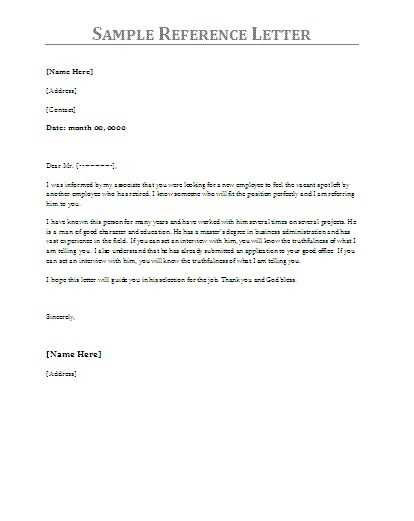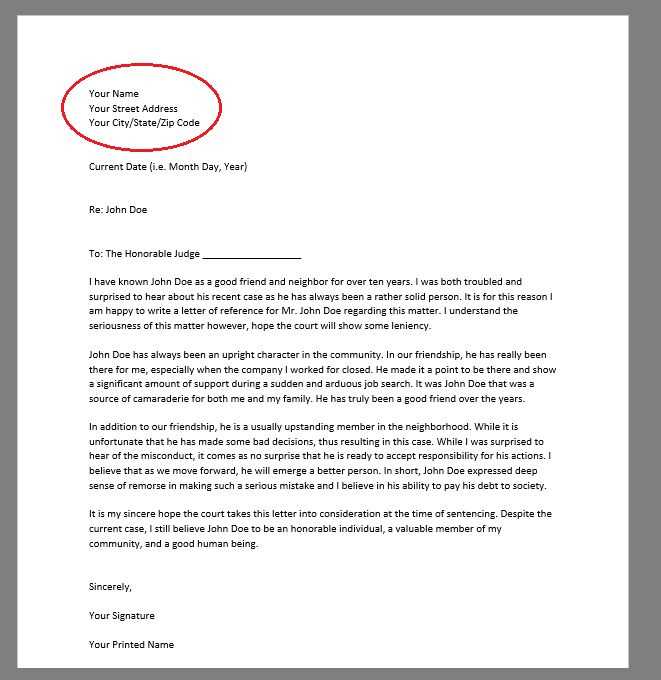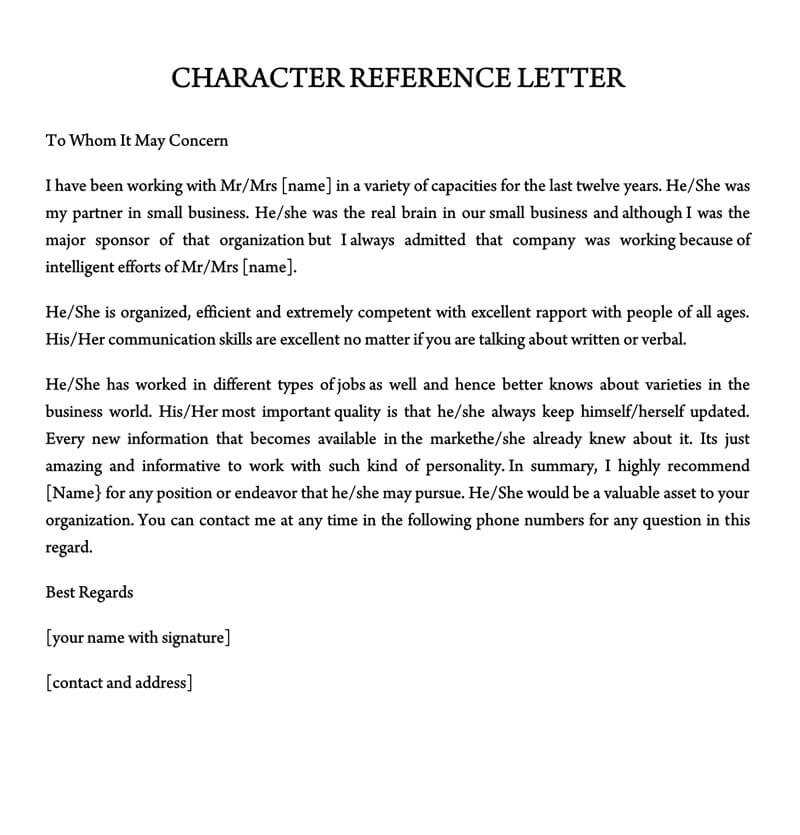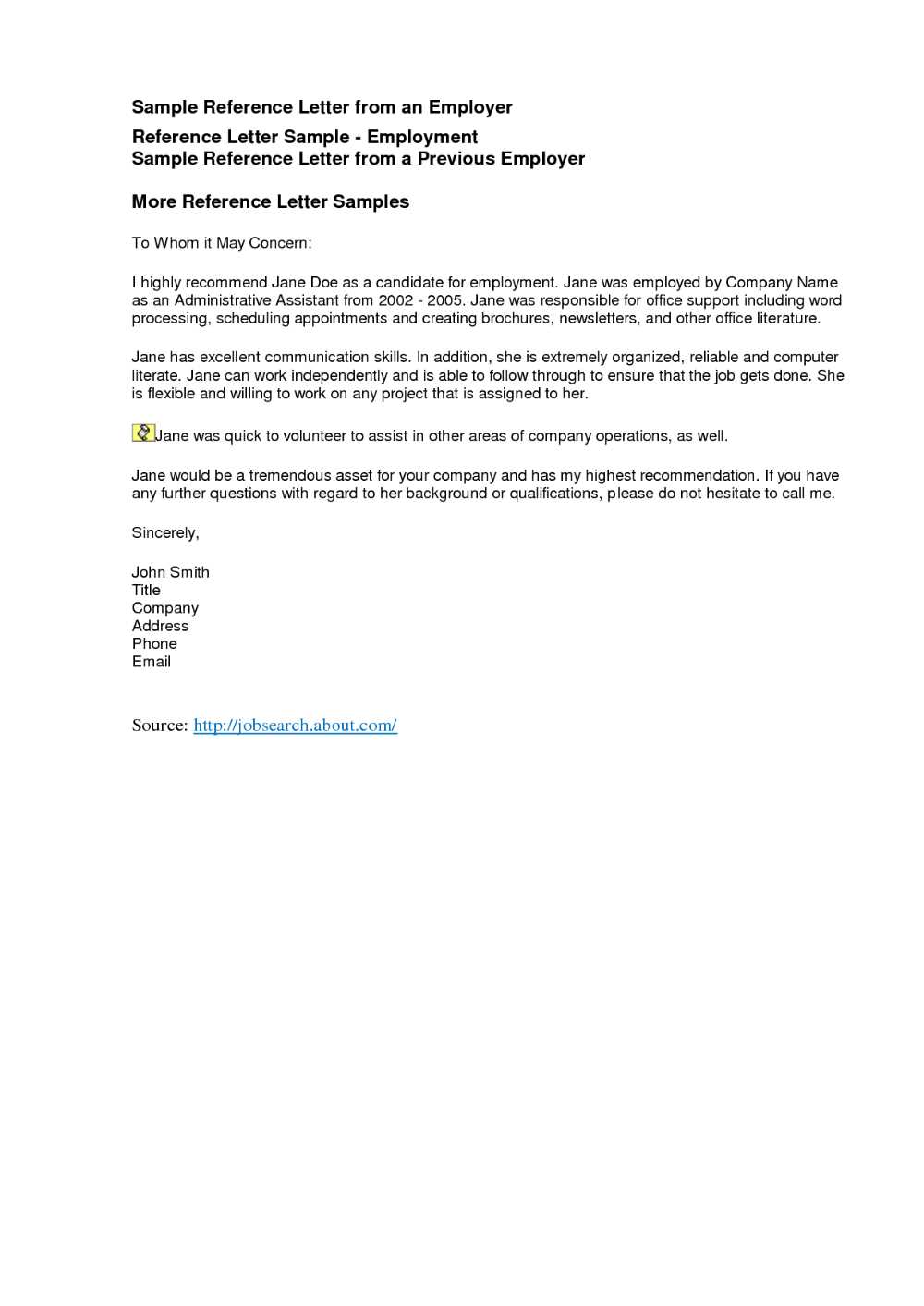Character reference letter template word

Writing a character reference letter is a simple yet impactful task that can provide valuable insight into someone’s personality, skills, and values. If you are tasked with drafting one, it is crucial to focus on key elements that truly reflect the individual’s character, rather than just listing generic qualities. A well-written letter can significantly influence decisions in both personal and professional settings.
Start by addressing the letter directly to the recipient, ensuring it is personalized to the situation at hand. Highlight the specific qualities and experiences that make the person stand out, such as reliability, kindness, or integrity. Be clear about your relationship with the individual, including how long you’ve known them and in what capacity. This helps build credibility and establishes the context for your recommendation.
In addition to outlining positive traits, providing concrete examples of the person’s actions or achievements can strengthen your message. Rather than relying on abstract descriptions, share stories or situations where their qualities were clearly demonstrated. These examples will make your letter more compelling and authentic.
Remember to maintain a tone of sincerity throughout the letter. While you should certainly highlight the individual’s strengths, honesty is key. If there are areas where they could improve, it’s important to mention them constructively, ensuring the reference remains balanced and truthful.
Character Reference Letter Template Guide
Creating a character reference letter is straightforward when you follow a structured approach. Focus on clarity and sincerity while highlighting the key qualities of the person you’re recommending.
The first step is introducing yourself and stating how you know the individual. Mention how long you’ve known them and in what capacity. This establishes your credibility as a reference.
Next, describe the individual’s personal qualities. Focus on specific traits that demonstrate their character, such as honesty, responsibility, and kindness. Instead of vague adjectives, provide concrete examples that showcase these qualities in action.
In the body of the letter, mention any accomplishments or experiences that reinforce the person’s reliability and integrity. Use relevant situations that highlight their positive impact on others or their community.
Finally, conclude the letter by offering your endorsement. Restate your belief in their character and explain why you think they will be an asset in the context they are applying for. End with a polite offer to provide further information if needed.
- Include your contact details for verification.
- Keep the tone professional yet personal.
- Stay focused on the person’s character and traits relevant to the position or purpose.
A well-structured character reference letter emphasizes the positive traits of the individual, providing a clear and impactful recommendation for the reader.
How to Structure a Character Reference Letter
Begin with a clear and formal greeting that addresses the recipient by name if possible. Start the letter by stating your relationship with the individual, specifying how long you’ve known them and in what context. This establishes your credibility as a reference.
The body of the letter should be divided into two key sections. In the first, highlight the individual’s qualities, focusing on characteristics such as honesty, reliability, and dedication. Provide specific examples that illustrate these traits in action. For instance, mention a time when the person demonstrated these attributes in a particular situation.
In the second section, discuss the person’s suitability for the role or situation they are applying for. Emphasize their skills and abilities that align with the requirements. Again, use concrete examples to strengthen your argument.
Conclude the letter by offering your strong recommendation. Avoid vague statements; make it clear that you fully support the individual. Include your contact details in case the recipient requires further information.
Finish with a polite closing, such as “Sincerely” or “Best regards,” followed by your name and signature if submitting a hard copy.
Key Information to Include in the Letter
Provide the full name of the person you’re recommending, including their professional or academic title, if applicable. This helps establish context for the recommendation. Mention how long you’ve known the person and in what capacity to demonstrate your familiarity with their qualities.
Details about the Individual
Focus on specific qualities or skills that make the person suitable for the position or opportunity they are seeking. Highlight examples of their work or behavior that directly relate to the request, whether in a professional, academic, or personal setting.
Relationship and Context
Clearly describe your relationship to the person. This includes your role in their life, whether as a colleague, supervisor, mentor, or teacher, and the context of your interactions. This helps to establish your credibility as a reference.
| Information | Description |
|---|---|
| Full Name | Include the person’s full name and any relevant title. |
| Duration of Acquaintance | Specify how long you’ve known the individual and in what capacity. |
| Key Qualities or Skills | Provide specific examples that demonstrate their skills or character. |
| Relationship Context | Clarify how you know the person and the nature of your interactions. |
Common Mistakes to Avoid When Writing

Focus on being specific and clear. Avoid vague language that could confuse the reader. Instead of general phrases, provide concrete examples that illustrate the qualities of the person you are recommending.
Overuse of Flattering Adjectives

Using words like “amazing” or “outstanding” too frequently can make the letter sound generic. Highlight specific achievements or qualities that demonstrate the person’s strengths, such as their problem-solving skills or leadership abilities.
Lack of Structure

Ensure the letter has a clear beginning, middle, and end. Introduce the individual, explain how you know them, and provide relevant examples. Conclude with a strong endorsement. A scattered, disorganized letter can weaken the impact.
Avoid excessive length. Keep the letter focused, concise, and to the point. Irrelevant details distract from the main message and reduce the letter’s effectiveness.
Don’t make unsupported claims. Back up your positive statements with real examples. This gives credibility to your recommendation and makes the letter more convincing.
Lastly, proofread thoroughly. Errors in spelling, grammar, or punctuation can harm the professional tone of your letter.
Choosing the Right Tone and Language
Maintain a polite, respectful tone while ensuring clarity. Focus on being honest and straightforward about the person’s qualities. Avoid overly formal or stiff language that can come off as impersonal. Aim for a conversational yet professional style, reflecting both warmth and sincerity.
Use specific examples to support your points. Describe the person’s achievements or characteristics in detail, rather than making vague statements. Highlight their strengths without exaggerating or making unfounded claims.
Be mindful of your word choice. Opt for positive, action-oriented verbs that showcase the person’s impact. Steer clear of overly casual language or slang, as it may detract from the letter’s credibility.
Finally, tailor your tone to the nature of the relationship. If it’s a professional reference, lean towards a formal yet friendly style. If it’s a personal reference, a warmer, more familiar tone may be appropriate while still maintaining professionalism.
Formatting Tips for a Professional Appearance
Align your text to the left to ensure readability. Centered text can be hard to follow in longer paragraphs. Maintain consistent line spacing; typically, 1.15 to 1.5 is ideal. This helps the reader easily scan through the content. Avoid large blocks of text by breaking up your letter into clear, concise paragraphs.
Choose a clean, professional font like Arial, Times New Roman, or Calibri with a size of 11 or 12 points. This ensures that your letter is easy to read while maintaining a polished look. Use bolding or italics sparingly–this is best for headings or highlighting important details without overwhelming the reader.
Keep margins at a standard width of 1 inch on all sides. This creates a balanced look on the page and leaves enough space for potential annotations. A uniform margin prevents any content from feeling cramped or cluttered.
Use clear headings and subheadings to organize your content. This structure makes it easier for the reader to find relevant information quickly. Be mindful of the spacing between headings and the body text to keep the document clean and organized.
Avoid excessive use of colors or decorative fonts. Stick to a neutral color scheme, such as black or dark gray, to maintain a formal tone. A simple and clean presentation reflects professionalism and respect for the reader’s time.
Double-check for typos or formatting errors before sending your letter. These small mistakes can distract from the overall professionalism of your letter. A well-formatted and error-free document communicates attention to detail and credibility.
How to Personalize the Template for Different Situations
Tailor the letter to match the purpose, whether it’s for a job reference, personal recommendation, or academic support. Adjust the tone based on the relationship with the person you’re recommending. For a professional reference, maintain a formal, business-like tone, focusing on the person’s skills and achievements. For a personal reference, incorporate a warmer, more personal style that highlights character traits and personal experiences. In academic references, emphasize the person’s intellectual abilities, dedication, and achievements within an educational context.
Next, customize specific details. If the template mentions general skills or qualities, replace these with concrete examples that demonstrate how the person excels in those areas. For example, if the letter highlights problem-solving skills, include a specific scenario where the individual solved a challenging situation. This adds authenticity and strengthens the reference.
Also, adapt the level of detail based on the recipient. If the letter is addressed to a hiring manager, focus on the individual’s professional accomplishments and skills relevant to the job. If it’s for a landlord or someone in a community setting, concentrate on trustworthiness, responsibility, and character traits that fit the context. Tailoring the letter this way ensures it resonates with the recipient’s specific needs.